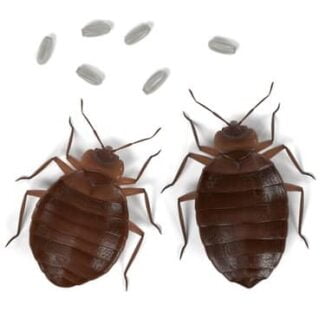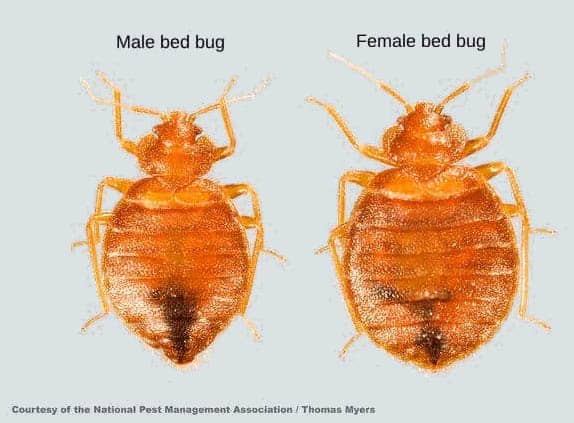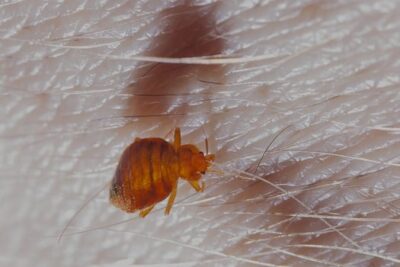Bed bugs thrive because they reproduce quickly, and in huge numbers. If it were possible to stop them from doing so, we could control their population, and perhaps get rid of them for good. That’s why it’s so important to understand how they mate, and where and how they lay eggs.
Bed bugs use a process called traumatic insemination to reproduce. The male breaks the female’s shell to inject sperm into a cavity called the hemocoel. It travels around the bed bug’s ‘bloodstream’ to the ovaries and fertilizes the eggs. The female will then leave to find another harborage and lay eggs for 6-8 weeks after mating just once.
It’s important to understand how bed bugs reproduce. Their reproductive cycle is key to how they establish new infestations, and how they can double, triple and quadruple in size within weeks.
The Bed Bug Reproduction Cycle
Here’s a basic guide on the bed bug reproduction cycle:
- Bed bugs begin life as eggs, about as big as a grain of rice.
- The eggs hatch into a nymph, which looks like a smaller version of an adult bed bug.
- The nymph goes through five stages called instars, after which it’s a fully mature adult. At each stage, it molts its shell.
- Once the nymph becomes an adult, it can start to mate. Bed bugs reproduce through a process called traumatic insemination, where the male breaks through the female’s shell and injects sperm into a body cavity. The sperm travels through the female’s body and fertilizes her eggs.
- Over the next six to eight weeks, the female will lay roughly an egg a day. She can mate again, and continue laying eggs.
This whole process happens over the course of about two months, and each female can lay more than two hundred eggs in the right conditions. Infestations can snowball.
Can Bed Bugs Reproduce Asexually?
Asexual reproduction refers to reproducing without ever mating. Some species of reptile only reproduce asexually, never having developed the need to mate.
Without exploring in too much depth how it works, the female can essentially split and recombine her genetic material to create something new each time.
So, do bed bugs have to mate to lay eggs? Bed bugs lack any biological way to reproduce asexually. They need both sperm and eggs, i.e., genetic material from a male and female.
It’s a good job that bed bugs can’t reproduce asexually. If that were possible, then infestations would spread far more easily than they do already.
Can Bed Bugs Reproduce Without a Mate?
There are two different ways to reproduce without mating. The first is asexually. This is where the insect fertilizes its eggs. But there’s another way which some species rely on.
It will mate at a particular time of year—say in the spring, which is breeding season for many species. However, the female’s eggs won’t be fertilized.
Usually, this is due to a problem with the male—perhaps their sperm isn’t healthy. But in this case, it’s because the female is storing it up rather than ‘using’ it straight away to fertilize her eggs.
She can then choose to fertilize her eggs later in the year, perhaps if no better mate has come along. So, while bed bugs can’t reproduce asexually, is this something they can do?
Bed bugs only need to mate once every six to eight weeks, at which point they’ll need to mate again to create fertile eggs. They don’t need to mate every time she wants to lay eggs.
This allows a female bed bug from an existing infestation to move somewhere new, and start a new infestation from scratch. Because bed bugs don’t have social structures like humans, that female will happily mate with her offspring.
Do Male Bed Bugs Lay Eggs?
Males lack the organs necessary to be able to create and lay eggs, which the female has. In the same way, the female lacks the organs that she could use to fertilize eggs.
While it’s quite difficult to spot the differences between male and female bed bugs, they’re different on the inside.
If you bring just one of them home, and it happens to be a male, then you won’t get an infestation unless he finds a female somewhere.

How Do Bed Bugs Mate?
Bed bugs mate through a process called traumatic insemination.
This is a mating method common among insect species, but not in more developed animals. The male bed bug clambers on top of the female to start mating.
Traumatic insemination is where the male breaks through the female’s exoskeleton with a body part called an aedeagus. The aedeagus is a long, sharp reproductive organ that performs the same function as a penis.
The male will inject sperm into the female’s abdominal cavity, called the hemocoel. The sperm will then travel through her body through a system essentially analogous to the bloodstream, before arriving at her ovaries, where it will fertilize her eggs.
According to the Royal Society, she has a special organ called the spermalege, or Organ of Berlese. The spermalege is unique to bed bugs, and is the best location from which the sperm can travel around her body. It’s located on the right side of her body.
Since it’s visible through her shell, it’s almost like a target for the male to aim at. Studies suggest that the male will generally aim at the spermalege, and that it may somehow also act to prevent infections of the wound that’s left behind.
When Do Bed Bugs Mate?
Bed bugs don’t have a mating season. They’ll breed and lay eggs all year round, which is part of what makes them so good at starting new infestations.
This is possible because the temperature indoors is more consistent, so even if it’s cold outside, the temperature in your bedroom will be just right for your uninvited guests.
However, that doesn’t mean that bed bugs are raring to go, whenever they like. According to BMC Biology, bed bugs start to show an interest in mating just after they’ve fed.
There are various reasons why that’s likely to be the case. They have more nutrients in their systems, meaning that they can produce more fertile sperm and eggs.
Females are also likely to move slower after they’ve just eaten. While the female does want to mate and produce young, it’s also highly stressful since she gets injured, so she’s often reluctant.
Being slower makes her easier to catch. Her spermalege will also be more easily visible as her abdomen is extended, engorged with the blood she’s digesting.
How Long After Mating Does a Bed Bug Lay Eggs?
Mammals have long gestation periods, as our young develops and matures inside us. But insects do things differently.
Because they lay eggs, the female doesn’t have to carry her young around inside her. Instead, she creates a hard egg and hides it somewhere that it can develop in peace.
Because they don’t have to wait for their young to develop before laying an egg, bed bugs can start laying eggs shortly after mating.
The male’s sperm travels through the bed bug’s equivalent of a bloodstream, so it reaches the ovaries quite quickly. She then has to develop the eggs inside herself, which takes a few days.
Over these few days, the female will usually leave her harborage in search of somewhere new. The process of traumatic insemination leaves behind a wound, which becomes a scar.
If she were to stay among the males of her previous harborage, they would also try to mate with her, and make the wound worse. She’ll try to find somewhere else to live before laying her eggs there.
She’ll then lay eggs continually for weeks afterwards. After six to eight weeks, she’ll need to mate again. Ideally, she’ll mate with perfect timing, so that she never has to stop laying eggs at all. A single female can, therefore, be responsible for an entire infestation, hundreds-strong.
How Many Eggs Does a Female Bed Bug Lay?
Insects breed quickly, and lay lots of eggs. Evolutionarily speaking, there’s safety in numbers, so that even if you kill dozens of insects in an infestation, there will still be hundreds more. That’s why bed bugs, too, lay lots of eggs—but, how many eggs do bed bugs lay?
Female bed bugs can lay somewhere between 200 and 250 eggs throughout their lifetimes. One particular study found a bed bug that laid more than 500, although she was a particularly fertile outlier, and far from the average.
The warmer the temperature, the more eggs the female will lay, since warm temperature provide optimum feeding and breeding conditions.
Tropical bed bugs lay fewer eggs than our original U.S. species, Cimex lectularius. Whereas a regular bed bug will lay around 200 eggs during her lifetime, a tropical bed bug is only likely to lay 50.
As for how many eggs a bed bug will lay at a time, she won’t lay them in big clutches. She’ll lay between 5 and 8 eggs per week, for up to 18 weeks.
And how many bed bugs will hatch from just one egg? There will only be one. She’ll need to continually feed during this period, as the creation of eggs requires lots of nutrients.
Where Do Bed Bugs Lay Eggs?
Bed bugs are highly selective when it comes to where they lay their eggs. They won’t just pick a random surface, least of all somewhere that’s out in the open. Instead, they’ll pick:
- Underneath your mattress. It’s a myth that bed bugs only live in bedding, but they do prefer the underside of your mattress or box spring. Points in favor are that it’s a shaded location, rarely disturbed, and is very close to you while you sleep. There are also lots of cracks and crevices, like mattress piping or the nearby frame of your bed.
- Underneath nearby furniture. Again, the underside of something like a bedside cabinet is shaded and seldom disturbed. The only downside is that they have to travel further to reach you (to feed).
- Around the house, especially in the living room. Bed bugs will make their home inside living room furniture like the couch, especially if you sometimes sleep there. This isn’t a primary infestation location, though, since the bed bugs would only be able to feed infrequently.
- Inside electrical outlets and cracks in the wall or floor. Bed bugs can find their way into the tiniest gaps, and they understand that these places are safe, so they lay their eggs there. Again, these aren’t a bed bug’s first choice, due to the distance from you as you sleep.
Wherever the female chooses to lay her eggs, though, it’s likely to be far away from her original harborage. Bed bug females try to get as far away as possible from their home to lay their eggs, to avoid mating again (as discussed). This aids them in starting new infestations.
Do Bed Bugs Lay Their Eggs on You?
Bed bugs don’t want to live on their host. They’re only attracted to you when they want to feed, by the smell of carbon dioxide and the chemicals that your skin gives off.
They find it very difficult to hold onto skin or hair. They’re the wrong shape, being too wide to crawl through head hair comfortably, and they even find body hair challenging to navigate. They also don’t have the claws that lice do with which they can grip onto hairs.
Besides that, if they were to lay their eggs under human skin or on you, you would notice them and brush them away.
That would limit how many bed bugs successfully hatch, which is why they don’t do it. Instead, they’ll pick somewhere dark and secluded where their eggs can hatch in peace.
What Do Bed Bug Eggs Look Like?
Bed bug eggs are like small grains of rice. They’re the same shape and color, but they’re a little bit smaller. They range in size from 1mm to 0.5mm. When the female first lays them, they’re sticky, so they’ll stick to the fabric of your mattress or sheets.
You’ll find them around bed bug harborages. Harborages are the places where bed bugs live, like the undersides of furniture, or the underside of your mattress. They’re dark places where there’s little chance of being disturbed.
Bed bugs lay their eggs there, especially in any nearby cracks or crevices. They are typically quite difficult to see against the fabric, although they’re easier to spot if there are lots of them.
They’re tough to get rid of because they easily get stuck to the fabric. Bed bugs use a sticky solution to keep their eggs in place, preventing them from rolling away and experiencing damage. This can leave a slight sheen on them.
How Long Does It Take for Bed Bug Eggs to Hatch?
Once the female lays her eggs, it takes them between 6 and 17 days to hatch. That might seem like quite a wide range, and it is. Imagine if a person took between 9 and 19 months to have their baby. So, why do bed bug eggs hatch so irregularly?
It’s all down to temperature. Bed bugs mate, feed, digest and hatch quicker when it’s warm. When it’s between 85 and 90 degrees, bed bugs can digest far more quickly than they can when it’s cold.
It’s the same principle at work which keeps food fresh in the fridge, or makes it spoil when it’s left out. Food breaks down more quickly in the heat.
But aside from that, it also helps bed bugs develop. Because there are more nutrients available to them, they grow larger more quickly, and mate and lay eggs more frequently.
The bed bug nymphs inside those eggs grow larger than they usually would, too, until they can hatch after just a week instead of between two and three weeks like usual.
Do All Bed Bug Eggs Hatch Successfully?
Under favorable conditions, the vast majority of bed bug eggs hatch successfully. At typical temperatures in a bedroom, somewhere around 95-100% of bed bug eggs will hatch as intended.
This is a high number, since most insects that lay hundreds of eggs don’t successfully hatch them all. But because bed bug eggs are so hardy, an infestation can double in size in just sixteen days.

Do Bed Bugs Have Larvae?
Bed bugs don’t come from larvae, at least not in the same way that butterflies and similar insects do. A larva isn’t just any recently-hatched insect. It’s a distinct juvenile stage that’s morphologically different from an adult.
To reach adulthood, the larva has to go through a drastic change (metamorphosis), which changes its body shape and organs. Think of caterpillars and butterflies.
What hatches from the egg is called a nymph. Bed bug nymphs are morphologically similar to adults. They have the same body shape, number of legs, organs, diet, and the same behavior. The only differences are that they’re lighter in color, and are a lot smaller than an adult bed bug.
Rather than going through one big change, metamorphosis, bed bugs go through several little changes throughout their life. These are called ‘instars,’ which means insect development stages.
Bed bugs go through five instars, the nymph being called the first instar. The second instar is slightly larger, the third bigger still, the same process repeated again and again as the bed bug ages. Each time it progresses to the next stage, it sheds its shell so that it can get bigger.
When it’s warm, a bed bug can progress from newly-hatched nymph to fully-grown adult in just three weeks. Unfortunately, bed bugs will feed each time they progress from one instar to the next. Considering the number of nymphs in an infestation, that’s a lot of bed bug bites.
How Quickly Do Bed Bugs Reproduce?
Bed bugs reproduce fast. Insects generally reproduce very quickly, which is an evolutionary adaptation: tiny life forms that reproduce faster than rabbits are almost impossible to kill off entirely.
So, how fast do bed bugs reproduce? A bed bug isn’t able to reproduce before it is a fully mature adult, which takes, according to the University of Kentucky around a month or so at regular room temperatures. They will then mate and continually lay eggs until they die.
Their lifespan changes depending on the temperature. Where temperatures were set at 50 degrees, a once-fed adult could live for almost five hundred days.
A tropical bed bug at the same temperature lasts three hundred days. The time it would take for a bed bug to reproduce is very heavily reliant on both temperature and available food.
Do Nymphs Feed on Blood?
Nymphs have the same feeding apparatus as adults, just a little smaller.
They have a small claw of sorts near their mouth, which they use to scratch a hole in your skin, and a separate tube similar to a mosquito which they insert into the wound. They use their saliva, just like adults, to slightly numb the area to prevent you from noticing them.
Once they’ve started feeding, it takes between five and ten minutes for them to become full. Once they’ve finished eating, they’ll head back to their harborage to digest for a few days.
They need to both feed and shed to grow to their next life stage (instar). Bed bugs don’t feed on anything but blood. They lack the teeth, gums, lips, and tongue that we have. All they have is their feeding tube, which is perfectly designed to help them feed on blood.
How Long Does It Take for a Nymph to Feed?
Unfortunately, bed bug nymphs seek out a blood meal as soon as they hatch from their egg. They need a blood meal to grow to the next stage, and they want to do that as quickly as possible. They will hatch from their egg hungry and searching for you.
Once they’ve fed for the first time, they need to digest their meal. This takes three or four days, as they need to digest the meal, shed their shell and then seek you out again.
They’ll continue to feed regularly like this for the rest of their lives, growing through each life stage. They’ll then need to feed to fuel the mating process.
They’ll then create more eggs, and the cycle begins again.
Can You Stop Bed Bugs from Reproducing?
Bed bugs are widespread is because they reproduce quickly. If hypothetically you could stop them from reproducing, you could stop an infestation from growing out of hand.
The best way to guarantee that bed bugs won’t reproduce is by killing them outright with a pesticide. The most commonly available pesticides contain permethrin, which is deadly in small concentrations, and lingers for weeks after it’s sprayed.
However, there are a group of chemicals called ‘insect growth regulators’ which interfere with nymphs and stop them from molting.
IGRs, as they’re known, suppress certain hormones which usually trigger nymphs to molt. Because the molting process is never triggered, the bed bugs can’t grow up into adults, meaning they can never reproduce.
IGRs are available to buy alongside regular insecticides. Sometimes, they’re paired with an insecticide, so that the spray has a double action.
Do Bed Bugs Breed Without Feeding?
Another way to stop bed bugs from breeding is to stop them from feeding. If the female doesn’t have access to regular blood meals, then she won’t be able to lay eggs.
Bed bug females need nutrients to create eggs and the young inside them. Insects don’t naturally have fat reserves like mammals do, so they need to feed consistently to create their offspring. If you were to deprive the female of food, she wouldn’t be able to reproduce effectively.
You could do this by fitting a mattress encasement to your bed. The bed bugs that are part of the harborage inside would be able to continue breeding, at least for a while.
But after a couple of weeks, they wouldn’t be able to continue laying eggs, as an encasement stops them from being able to access their host.
Do Bed Bugs Ever Stop Breeding?
Bed bugs will continually breed until they die. However, there is a limit to how much a female can breed throughout her lifetime. Remember earlier, when we learned that traumatic insemination leaves a scar on the female’s abdomen?
Well, if she continues mating, that scar will get worse. And because of the location of the scar, it can make it quite difficult for her to continue to lay eggs.
The same applies throughout her life. A bed bug female that mates with just one male will lay 25% more eggs than a female that’s mated repeatedly.
The female doesn’t need to be mated time after time, as bed bugs are typically highly fertile, and can lay eggs for weeks on end after mating just once. It would all be simpler if they did away with traumatic insemination, and mated like other insects do.
Can You Tell If a Bed Bug is Pregnant?
You happen to see a bed bug crawling on your sheets. Searching for more, you can’t see any under your mattress, in nearby furniture, or anywhere else you look. It could have been the only one.
If it was a female, then it may have been fertilized and able to lay eggs. So, is there any way to tell? Unfortunately, no. They don’t leave behind dozens of eggs when you crush them. And they don’t get heavily and visibly pregnant.
You can easily tell a male from a female. Males have a longer abdomen, with a distinctive point at the end. A female’s abdomen is shorter and more rounded, although still not perfectly circular. The female doesn’t change shape if she’s laying eggs or not.


